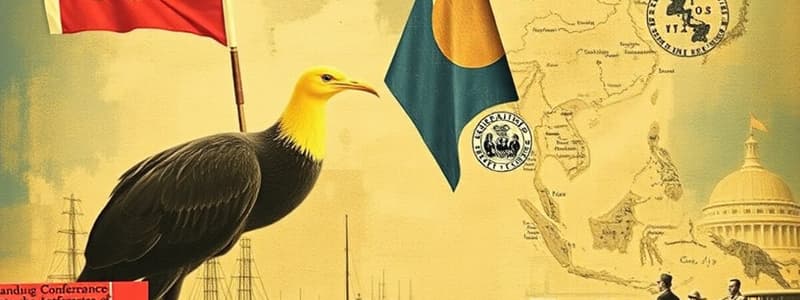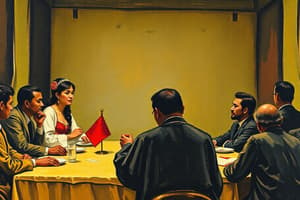Podcast
Questions and Answers
What was one of the key aims of the Bandung Conference in 1955?
What was one of the key aims of the Bandung Conference in 1955?
- To encourage the spread of communism in Southeast Asia.
- To strengthen alliances with Western nations.
- To promote economic and cultural cooperation among newly independent nations. (correct)
- To create a military pact among Asian countries.
Which leader was NOT a key figure at the Bandung Conference?
Which leader was NOT a key figure at the Bandung Conference?
- Jawaharlal Nehru
- Sukarno
- Kwame Nkrumah
- Mahatma Gandhi (correct)
What significant movement was laid down as a result of the Bandung Conference?
What significant movement was laid down as a result of the Bandung Conference?
- The Pan-African Movement.
- The Pacific Alliance.
- The Non-Aligned Movement (NAM). (correct)
- The ASEAN Charter.
What issue did Vietnam face after the Bandung Conference?
What issue did Vietnam face after the Bandung Conference?
Which country struggled with political instability due to fears of communist influence following the conference?
Which country struggled with political instability due to fears of communist influence following the conference?
What challenge did the Philippines face in establishing its national identity post-Bandung?
What challenge did the Philippines face in establishing its national identity post-Bandung?
Malaya faced tensions between which ethnic groups after gaining independence?
Malaya faced tensions between which ethnic groups after gaining independence?
What internal challenge did Indonesia encounter after the Bandung Conference?
What internal challenge did Indonesia encounter after the Bandung Conference?
Which of the following statements best reflects the overarching aim of the Bandung Conference?
Which of the following statements best reflects the overarching aim of the Bandung Conference?
Which country emerged with significant internal challenges following the Bandung Conference due to its diverse islands?
Which country emerged with significant internal challenges following the Bandung Conference due to its diverse islands?
What was a significant consequence for the global South stemming from the Bandung Conference?
What was a significant consequence for the global South stemming from the Bandung Conference?
Which of the following best describes Vietnam's situation after the Bandung Conference?
Which of the following best describes Vietnam's situation after the Bandung Conference?
Which country struggled with issues related to colonial legacies and the rise of communism after the conference?
Which country struggled with issues related to colonial legacies and the rise of communism after the conference?
How did the Bandung Conference impact the perception of newly independent nations on a global scale?
How did the Bandung Conference impact the perception of newly independent nations on a global scale?
What primary concern did Thailand face post-Bandung Conference?
What primary concern did Thailand face post-Bandung Conference?
Which issue primarily challenged the Philippines in establishing its national identity after the Bandung Conference?
Which issue primarily challenged the Philippines in establishing its national identity after the Bandung Conference?
Post-Bandung, Malaya confronted tensions arising mainly from disputes among which groups?
Post-Bandung, Malaya confronted tensions arising mainly from disputes among which groups?
What general theme characterized the Bandung Conference in terms of member countries' diplomatic relations?
What general theme characterized the Bandung Conference in terms of member countries' diplomatic relations?
Flashcards
Bandung Conference (1955)
Bandung Conference (1955)
Large Asian-African conference promoting cooperation, opposing colonialism, and racial equality.
Non-Aligned Movement (NAM)
Non-Aligned Movement (NAM)
Movement formed after the Bandung Conference, avoiding alliances with superpowers during the Cold War.
Vietnam War
Vietnam War
Conflict in Vietnam (1955-1975) caused by the challenge of unifying North & South Vietnam under communist rule.
National unity challenges (Southeast Asia)
National unity challenges (Southeast Asia)
Signup and view all the flashcards
Indonesia's post-Bandung challenges
Indonesia's post-Bandung challenges
Signup and view all the flashcards
Philippines' post-colonial issues
Philippines' post-colonial issues
Signup and view all the flashcards
Southeast Asia post-independence
Southeast Asia post-independence
Signup and view all the flashcards
Challenges of Nationalism
Challenges of Nationalism
Signup and view all the flashcards
Bandung Conference
Bandung Conference
Signup and view all the flashcards
Key Figures at Bandung
Key Figures at Bandung
Signup and view all the flashcards
Impact of Bandung
Impact of Bandung
Signup and view all the flashcards
Vietnam's Unification Challenge
Vietnam's Unification Challenge
Signup and view all the flashcards
Thailand's Post-Bandung Challenges
Thailand's Post-Bandung Challenges
Signup and view all the flashcards
Indonesia's Internal Politics
Indonesia's Internal Politics
Signup and view all the flashcards
Philippines' Colonial Legacy
Philippines' Colonial Legacy
Signup and view all the flashcards
Malaya's Ethnic Tensions
Malaya's Ethnic Tensions
Signup and view all the flashcards
Impact on Southeast Asia
Impact on Southeast Asia
Signup and view all the flashcards
Internal and External Pressures
Internal and External Pressures
Signup and view all the flashcards
Study Notes
Bandung Conference (1955)
- Held in Bandung, Indonesia, in April 1955.
- First large-scale Asian-African conference.
- Attended by 29 countries, mostly newly independent or colonized nations.
- Key aims: Promoting economic and cultural cooperation, opposing colonialism, and supporting racial equality.
- Key figures: Jawaharlal Nehru (India), Sukarno (Indonesia), and Kwame Nkrumah (Ghana).
Impact of Bandung Conference
- Laid the foundation for the Non-Aligned Movement (NAM).
- Aimed to avoid alliances with either the Western or Eastern blocs.
- Raised the profile of newly independent nations, especially in regards to self-determination.
- Strengthened global South solidarity.
Challenges of Nationalism in Continental Southeast Asia
- Vietnam: Faced the challenge of unifying North and South under communist leadership, leading to the Vietnam War (1955–1975).
- Thailand: Struggled with political instability due to fear of communist influence.
- Cambodia/Laos: Experienced instability due to colonial legacies and the rise of communism in neighboring countries.
Challenges of Nationalism in Island Southeast Asia
- Indonesia: Faced internal political challenges, regional autonomy issues, and the desire to unify diverse islands.
- Philippines: National identity was challenged by remnants of American colonial influence and issues related to the Moros.
- Malaya: Gained independence from Britain in 1957, but tensions between ethnic groups (Malays, Chinese, Indians) posed challenges for national unity.
Common Challenges Post-Bandung
- Colonial Legacy: Many countries struggled with the aftereffects of colonial rule (e.g., poor infrastructure, political instability, ethnic divisions).
- Economic Development: Most nations were economically underdeveloped and needed focus on growth without external interference.
- Political Instability: Many countries faced struggles with leadership, military coups, and uprisings.
Nationalism's Impact on International Relations
- Nationalist movements led to shifting alliances in global politics.
- Countries sought to avoid Cold War entanglements
- Focus on sovereignty, independence, and economic self-reliance.
Studying That Suits You
Use AI to generate personalized quizzes and flashcards to suit your learning preferences.




